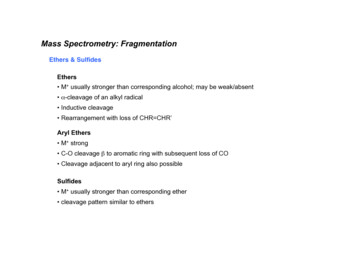
Transcription
and Learnall aboutSharksofMassachusettsThis book belongs to:
What is ashark?Sharks are a kind of fish. They areanimals that have vertebrae justlike you and me! Unlike us andmost fish, shark have no bones!Their skeletons are made up ofcartilage. Is there anywhere onyour body that has cartilage? Yournose, ears, and between all yourjoints are all places where youhave cartilage!There are over 400 species of sharksin the world. They live everywherefrom very cold waters of the arctic andantarctic to the warm waters in tropical seas. Massachusetts has their veryown shark visitors all year around!Let’s learn a little more about sharksand which ones visit Massachusetts.
How long have sharks existed?Sharks have been on Earth since before the dinosaurs! Some of theearliest known sharks were called cladoselache (clay-doe-SELL-ahkee). Scientists only know about these animals from fossils they haveleft behind. These early sharks lived about 370 million years ago. Dinosaurs showed up 230 million years ago and only survived to 65.5million years ago while sharks are still around today!
What is a Megalodon?The most famous extinct shark is the Megalodon. It was an ancientshark living 20 to 2 million years ago. Its name means ‘big tooth’, agood name for a shark that grew to almost 60 feet long! Megalodonslived throughout the oceans and is thought to have looked like a bigger version of the white sharks we see today.If an ancient megalodon was this bigthen a modern day white shark would be this big!
How big do sharks get?The largest shark in the worldis the whale shark. It can growto over 40 feet long!The smallest shark in the world isthe dwarf lantern shark which canonly grow to about 8 inches long!
Are sharks smart?They may not know the statecapitals, but sharks aren’t justmindless eating machines!Some sharks seem curiouswhile others seem cautiousaround animals they don’tknow. Some species maywork together while othersprotect their food source. Incaptivity, some sharks canlearn different behaviors andremember them over longperiods of time!
Do sharks have good vision?Most sharks can see very well. Some have better vision at night whileothers have better vision during the day. Shark eyes are about 10 timesmore sensitive than human eyes! They can dilate and contract theirpupils, like humans, to help see better!
Do sharks sleep?While some sharks can lay still and rest, many sharks have to keepswimming in order to breathe. This is called obligate ram ventilation.Most sharks rest parts of their brain at a time. They never fully fallasleep like we do!
Can sharks live in freshwater?Bull sharks and river sharkscan travel easily betweenfreshwater and salt water.Most sharks off the Massachusetts coast don’t likefreshwater.
Do sharks have scales?Like most fish, sharks do havescales! They are very small and arecalled denticles. Denticles are liketeeth that grow in the skin! Thesescales help protect sharks andmake swimming much easier!
How old do sharks get?Most sharks live somewherebetween 20 and 30 years.Some can live much olderthan that. Spiny dogfish areknown to live to over 70 yearswhile Greenland sharks andwhale sharks can live to over100!
Do sharks really have a 6thsense?We share five senses with sharks: sight, smell, taste, touch, and hearing. Sharks have another sense called electroreception. This sensehelps sharks find their prey with electricity through the jelly-filledpores on their snouts called the ampullae of Lorenzini.The underside of a smooth hammerheadshowing the ampullae of Lorenzini.
Can you find all of the sharksnames?Look up, down, diagonally, and SHERXLFNQXBaskingDwarf LanternSandbarSpiny DogfishBlueGreenlandShortfin MakoTigerCommonThresherPorbeagleSmooth DogfishWhaleDuskySand TigerSmoothHammerheadWhite
Help the spiny dogfish throughthe maze to find the squid!
CrosswordFigure out the clues below to fill in the crossword!(If you need help, look for the bold words in this book!)AcrossDown1The largest known modern shark2Jelly-filled pores on a shark3Hearing, sight, smell, touch, taste3We know about Megalodon by finding7What predators hunt4Backbone9Massachusetts is on the ocean5Sixth sense11 Teeth that grow on a shark’s skin612 Generally, a king of animal7An animal that is not living on Earth anymoreisThe largest modern ocean13 Smallest species of shark814 The largest shark that we know of in history15 Sharks have been around longer than thesegiant animals that used to rule the landHumans, sharks, and dinosaurs are all kindsof10 What our nose and ears are made of, also ashark’s skeleton
Connect the Dots!Connect the dots to see Sheldon Shark!
Basking SharkCetorhinus maximusWorld Range: Temperate and arctic, coastal and semi-pelagicEastern United States Range: Canadian border to Florida,throughout the Gulf of MexicoSize: Up to 40 feet long, second largest fish after the whale shark!Color: Light brown to dark gray or black on top; the same color toalmost white on the bellyFood: Filter-feed on zooplankton (small animals drifting in the waterlike fish eggs and young fish and crustaceans)Predators: No known predators
Blue SharkPrionace glaucaWorld Range: Temperate and tropical pelagicEastern United States Range: Canadian border to Florida,throughout the Gulf of MexicoSize: Over 12 feet!Color: Dark, vivid blue on top; bright blue on the sides; white underneathFood: Smaller bony fish like herring and sardines, invertebrates likesquid and octopusPredators: White shark, shortfin mako
Common ThresherAlopias vulpinusWorld Range: Temperate and tropical, coastal and pelagicEastern United States Range: Canadian border to Florida and intothe Gulf of Mexico; mostly found in New England watersSize: Up to 20 feet; half their length is their tail!Color: Dark brown to gray or black on top; white on the bellyFood: Squid and schooling fish like menhaden, herring, and mackerel;they stun prey with their tails!Predators: Larger sharks on juveniles
Dusky SharkCarcharhinus obscurusWorld Range: Temperate and tropical, continental coastlinesEastern United States Range: Canadian border to Florida,throughout the Gulf of MexicoSize: Over 12 feet!Color: Blue-gray or bronze-brown on top; white on the bellyFood: Bony fish like herring and tuna, other sharks and rays, invertebrates like crabs, squid, and sea starsPredators: Larger sharks on juveniles
PorbeagleLamna nasusWorld Range: Cool temperate and arctic, coastal and pelagicEastern United States Range: Canadian border to New JerseySize: About 12 feet long!Color: Dark blue to blue-gray, the first dorsal has a white or light graypatch; white on the bellyFood: Fish like herring and mackerel in the spring, sand lance andflounder in the fall, squid year-roundPredators: Possibly white sharks and killer whales, but no predationconfirmed
Sand Tiger SharkCarcharias taurusWorld Range: Temperate and tropical, coastalEastern United States Range: Gulf of Maine to Florida, throughout the Gulf of MexicoSize: Over 10 feet!Color: Light brown to gray on top, light gray to white underneathFood: Small bony fish like herring and flatfishes, rays, squid, lobster,and small sharksPredators: Larger sharks on juveniles
Sandbar SharkCarcharchinus plumbeusWorld Range: Temperate and tropical, coastal and pelagicEastern United States Range: Canadian border to Florida,throughout the Gulf of MexicoSize: Over 7 feet long!Color: Blue-brown on top, light blue-brown to white on the bellyFood: Small fish, mollusks, and crustaceansPredators: Large sharks on juveniles
Shortfin MakoIsurus oxyrinchusWorld Range: Temperate and tropical, pelagicEastern United States Range: Gulf of Maine to Florida, throughout the Gulf of MexicoSize: Over 12 feet!Color: Dark metallic blue on top with light metallic blue areas, white onthe bellyFood: Fast pelagic fish like swordfish, tuna, and sailfish; squidPredators: Larger sharks on juveniles
Smooth DogfishMustelus canisWorld Range: Temperate and tropical; coastal, only in the WesternAtlanticEastern United States Range: Massachusetts to Florida, throughout the Gulf of MexicoSize: Just under 5 feet long!Color: Gray to brown on top, yellow-gray to white on the bellyFood: Large crustaceans like lobster and crab; fish and mollusks too!Predators: Larger sharks like dusky, blacktip, and great hammerheadsharks
Smooth HammerheadSphyrna zygaenaWorld Range: Temperate, coastal and semi-pelagicEastern United States Range: Canadian border to FloridaSize: Up to 16 feet long!Color: Dark brown-green to brown-gray on top, white on the bellyFood: Bony fish, smaller sharks, rays, and skatesPredators: Larger sharks on juveniles
Spiny DogfishSqualus acanthiasWorld Range: Temperate and arctic, coastalEastern United States Range: Canadian border to FloridaSize: Under 4 feet longColor: Light to dark brown on top; light brown to white on the belly;white spots along the lateral lineFood: Schooling fish like herring, menhaden, and mackerel; may alsoeat wolffish, squid, sea jellies, and sea cucumbers!Predators: Cod, hake, goosefish, larger sharks, sometimes seals andkiller whales
Tiger SharkGaleocerdo cuvierWorld Range: Temperate and tropical, coastal and pelagicEastern United States Range: Canadian border to Florida;throughout the Gulf of MexicoSize: Up to 14 feet long!Color: Light brown to blue-green with darker splotchy spots on top andyellow-white on the bellyFood: Sea turtles, rays, other sharks, birds, dolphins, squid, and bonyfish; also found with soda cans and bottles in their tummies!Predators: Larger sharks on juveniles
White SharkCarcharodon carchariasWorld Range: Temperate and semi-tropical, coastal and pelagicEastern United States Range: Canadian border to Florida;throughout the Gulf of MexicoSize: Over 22 feet!Color: Blue-gray to gray-brown on top, white on the bellyFood: Marine mammals, other sharks, larger fish like tunaPredators: Killer whales
Draw your own shark!Use your imagination to think up your very own species of shark! Don’tforget to add fins, a tail, and gills!
For more information, visit our website!http://www.mass.gov/marinefisheriesAll content including information, games, and images, are the creation ofElaine Brewer for the Massachusetts Division of Marine Fisheries. She can be reached at:elaine.brewer@state.ma.usMassachusetts Division of Marine Fisheries251 Causeway Street, Suite 400Boston, Massachusetts 02114
Aug 30, 2017 · lived throughout the oceans and is thought to have looked like a big- . look for the bold words in this book!) Across Down 1 The largest known modern shark 2 Jelly-filled pores on a shark 3 Hearing, sight, smell, touch, taste 3 We know about Megalodon by finding _ . Light brown to gray on top,










